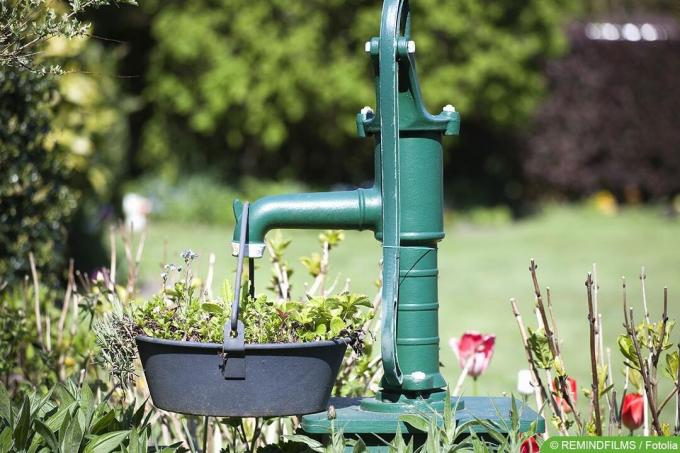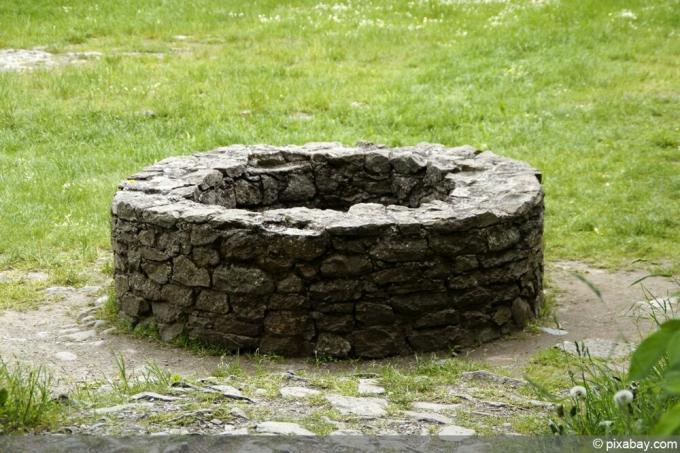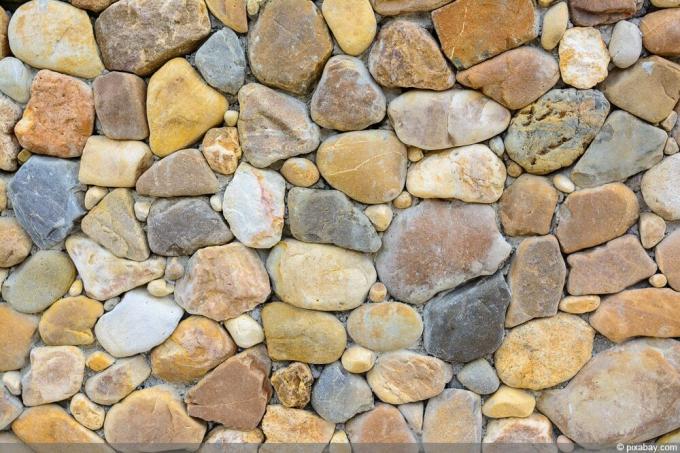

Table of contents
- Gabion retaining wall
- Suitable for hobby craftsmen
- Inexpensive and readily available material
- Decorative design element
- challenge in construction
- further requirements
- Concrete retaining wall
- Some advantages are obvious
- Specialist knowledge is required
- The dreary look is annoying
- L-brick retaining wall
- A heavy burden to bear
- The costs are in themselves
- This is something to keep in mind when building your own
Gardens are primarily for gardening and, of course, for recreation. But some gardens require additional structural skills from their owners. For example, when a retaining wall is needed to make a slope stable and safe. A professional does a good job, but is quite expensive. What options are there for setting up a suitable support on your own?
Gabion retaining wall
Gabion elements are relatively newcomers to the building materials market. The stone baskets are often also referred to as bulk baskets, brick baskets or wire gravel boxes. Lined up next to each other and filled, the baskets form a stately wall that is strong enough to safely support slopes.
- can be filled with natural stones
- Quarry stones from granite, river pebbles, limestone etc. ä.
- nature-friendly garden element
- safe shelter for insects and small mammals
Suitable for hobby craftsmen
If the preliminary planning is correct and the elements were purchased in sufficient width and depth, nothing can really go wrong when erecting the wall.
- Gabion baskets are easy to set up
- also by skilled hobby craftsmen
- Stability of the wall is not endangered
Inexpensive and readily available material
Metal containers for the filling material are now not uncommon. They are available in numerous hardware stores and online shops. The prices are cheap compared to costs incurred for other wall types. In order to discover the optimal price-performance ratio, a detailed comparison of the providers and the product features is necessary. This is a bit time-consuming, but saves money. Especially when it comes to filling with stones, a wide range of offers awaits.
Decorative design element
A hillside wall fulfills a supporting function, but not in secret. It is a clearly visible part of the garden. For everyone and anytime. It's good if the eye also likes it. Gabion elements are extremely versatile when it comes to the creative design of the wall look.
- looks more natural than concrete
- can even be planted/covered
- then it looks even more natural
- different filling material selectable
Tip:
A varied and individual look can be achieved by combining different filling materials. The wall becomes unique, so to speak.
challenge in construction

A supporting wall has a job to do that requires strength and stability. Ensuring this is the main challenge for every garden owner.
- sufficient height and depth required
- the steeper and longer the slopes, the more solid the wall must be
- possibly. seek professional advice on calculation.
further requirements
A gabion wall needs a secure footing right from the start. Walls under a meter high and at least 30 cm wide are content with a gravel bed. Larger walls require a foundation.
- stable concrete foundation must be erected
- 60 to 80 cm deep
- frost-free foundation is important
- very large walls must be additionally fortified
- in individual cases a drainage layer is required for drainage
Concrete retaining wall
Whether as a retaining wall for slopes, paths or beds, concrete used to be the first choice. Nowadays there are more alternatives available, but a plain concrete wall is still in demand.
Some advantages are obvious
A concrete retaining wall is a durable structure. Hardly anything going on in the garden can bring about their destruction. Where it is erected, it reliably holds the fort. Their construction requires little working time. The shape has to be right, you don't have to pay much attention to the beauty.
- There is no need to buy formwork
- they are for rent
- heavy material hauling is not necessary
- Concrete is usually delivered to the construction site
Specialist knowledge is required

A concrete wall is a fairly simple thing in appearance. Their construction, on the other hand, is quite demanding. If you have little experience in this regard, you will quickly reach your limits as a hobby bricklayer. The following work steps require precise work:
- building a strip foundation
- Compaction of the foundation with a vibrator
- the installation of welded wire mesh
- the concreting of reinforcement irons
- attaching the formwork
- the layering of gravel between the wall and the topsoil
In addition, a concrete wall must be erected at a slight incline to protect a slope.
The dreary look is annoying
A concrete wall is gray and boring. As an artificially created element, it seems a bit like a foreign body among the plants created by nature. Fortunately, this disadvantage can be mitigated with a little effort.
- Painting brings colour
- Stone or plaster cladding is possible at a later date
- Shaking up with topsoil and subsequent planting
L-brick retaining wall
L-stones look like the letter L, hence their name. They are also often referred to as angle stones. They are already produced and sold in this form. Lined up close together, they form a closed wall. But what sounds so easy is, in the truest sense of the word, a difficult challenge. The angle bricks are not as easy to build in the garden as Lego bricks are in the children's room.
A heavy burden to bear
An angle stone is heavy, very heavy. Even smaller stones with an edge length of 50 cm weigh a full 50 kg each. Hauling the stones is difficult, if not impossible, even for a well-trained craftsman. And once the stone has arrived at its destination, it also has to be precisely aligned.
- Do-it-yourself construction only makes sense for smaller projects
- use of machinery is necessary for larger walls
The costs are in themselves
While the costs remain within limits for smaller projects, they can almost explode with large walls. The largest item is accounted for by the necessary machines, without which the erection of the wall cannot be lifted. Five-digit amounts quickly add up. The effort is difficult to estimate and ultimately also the total labor costs. If the work is outsourced, a binding cost estimate should therefore be obtained beforehand.
This is something to keep in mind when building your own

The L-stones have an enormous weight, which has a permanent effect on the ground after they have been set up. A suitable substructure is absolutely necessary to ensure that there are no shifts over time.
- Substructure must be stable
- The basis is a gravel-sand mixture compacted with a vibrator
- a thin layer of concrete is applied to the mixture
- only then can the angle stones be set
An uneven layer of concrete also makes it difficult to align the tops of the stones evenly.
Tip:
You can rent a vibrator for compacting the gravel-sand mixture by the day or by the hour in many hardware stores.
 garden editorial
garden editorial I write about everything that interests me in my garden.
Learn more about gardening of all kinds

Laying out a garden – you should observe these guidelines
A well-kept garden is a real eye-catcher that enhances the house and property even more. When buying a new property or for seasonal renewal, the garden is designed with many new ideas and concepts. This can be quite expensive if not planned properly. Our article wants to show you how to create your new […]

Find water veins: At what depth does groundwater come?
A well on your own property must be connected to the groundwater. It is not always clear where this is located. Luckily, there are several methods that you can use to reliably track down a "water vein" to take advantage of the water source.

Build your own dowsing rod DIY instructions
Dowsing rods have been a working method for finding water and other things in our environment for centuries. With little effort, you too can easily make your own dowsing rod - with our instructions.

Lawn pavers: how does lawn repair work?
Bald spots or gaps in the lawn are a thorn in the side of many lawn owners. However, overseeding is considered to be tedious work. Relief should Provide lawn pavers that combine many work steps in one.

Build a Frisian wall yourself | Costs for a Frisian wall
The Friesenwall is used to separate gardens and flower beds from neighboring properties. It is aesthetic and offers a living space. The costs you will incur depend on the material you have chosen. Choosing DIY will save you money on labor.

Improve your income with gardening - is that possible?
If you put a lot of time, energy and love into your garden and this then also brings the corresponding successes in the form of a rich harvest shows, you can get the idea of whether you can improve your income with your gardening. We show what you should consider, what pitfalls there are and what opportunities you can offer.



